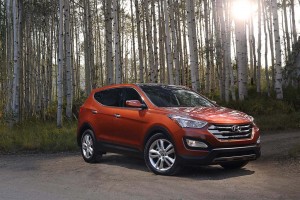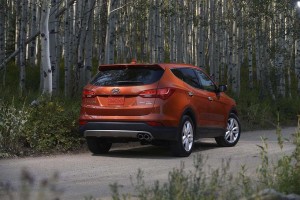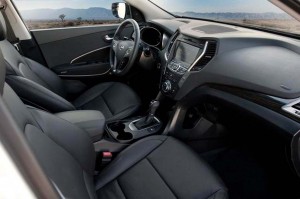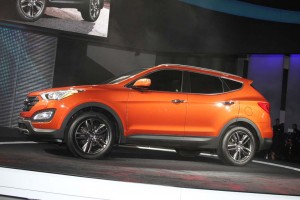Hyundai has been on a roll of late. But like an eager new homeowner it is still looking to knock down some walls to enlarge a space that it believes holds additional promise — which is precisely where the new 2013 Santa Fe comes into the picture.
Small crossovers are hot in today’s fast-changing market and Hyundai executives believe they aren’t getting a fair share of what is one of the fastest-growing segments. Hence, the 2013 Santa Fe has been groomed and tailored to make it more appealing to buyers looking for a blend of practical utility and new technology while also delivering on some of the old school automotive fundamentals such as power and good handling.
The 2013 Hyundai Santa Fe line-up is not a one-trick pony – and that means the updated line-up could be a bit confusing. There are actually two versions of the crossover-utility vehicles for 2013. The five-door Santa Fe Sport is the direct replacement for the outgoing model while the Santa Fe name — full stop — now goes onto a 3-row, 7-passenger offering that replaces the largely ignored Hyundai Veracruz.
For starters, the exterior of both versions of the new 2013 Hyundai Santa Fe incorporates the lines and styling cues Hyundai has already pioneered successfully on passenger car line’s like the Sonata and Elantra. However, the Santa Fe is more than say a square version of the Sonata.
The 2013 Santa Fe gets its own distinct style and appearance with nicely tailored corners and wheel arches as well as the fluid, sweeping lines running from front to back when viewed from the side, the company’s stylist have used to pull together the South Korean automaker’s other recent designs. The result is a crossover-utility vehicle that looks fresh and contemporary out on the road.
On the inside, the overall design is both stylish and efficient.
Hyundai has become pretty good at laying out the basic interior architecture. It also is deft at making the finished product look and feel more expensive by carefully modulating the materials and textures used at key touch points around the cabin.
The Santa Fe clearly benefits from this philosophy and even on a relatively long drive, the interior proved not only attractive but quite comfortable. The seats are supportive, the controls are easy to find and reach and the materials and overall layout of the interior helps limit the all too natural stress and fatigue that can overwhelm motorists even on relatively quiet drivers.
Certainly, one of the items on the punch list prepared by Hyundai’s engineering staff was to neutralize the exterior noise heard by the driver and passengers. My judgment says they succeeded.
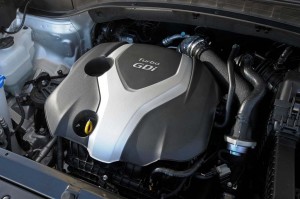
The 2013 Hyundai Santa Fe line launches with two I-4 engines, including the 2.0-liter turbo shown here.
The Santa Fe also comes with a long list of comfort and convenience features as well as a complete technology package — which includes Bluetooth, USB connections for use with music devices and an optional navigation system that is relatively easy to program and use when you’re out and about. The Santa Fe also comes with Hyundai’s Blue Link system which integrates the various digital features, making them easier to use quickly and hopefully safely.
Blue Link, for those not familiar with the new subscription service, has a lot in common with General Motors’ OnStar, and can be ordered in various tiers that begin with basic safety-and-security features.
Motorists’ safety concerns are also addressed with a complete array of airbags, including one to protect the driver’s knees, electronic controls for braking and stability and a sturdy, well-designed body capable of taking a serious beating during a crash while minimizing impact forces on passengers.
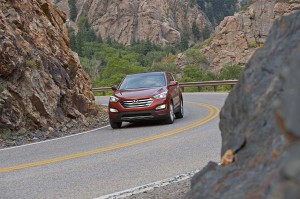
The new model's ride and handling is notably improved - though Hyundai still has suspension work to do.
Ride and handling remain Hyundai’s Achilles’ heel, something senior officials tell TheDetroitBureau.com is their top priority with future products. But there are signs, with the 2013 Hyundai crossover, that the maker is on the right track. I found the Santa Fe suspension and handling smooth and efficient and providing a fair sense of the road.
To be clear, the 2013 Hyundai Santa Fe is a soft-roader. Yes, you can deal with serious snow and maybe the rutted mud and gravel roads you’ll find on the way to the family’s cabin. But if you’re looking for serious off-road capabilities, look elsewhere.
On the other hand, powertrains are one of the areas in which Hyundai has received strong marks of late and the Santa Fe follows the trendline.
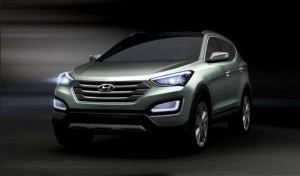
Hyundai is hoping to expand the appeal of the Santa Fe by offering both short and long versions for 2013.
The 2.0 liter inline-four with Hyundai’s special blend of turbocharging and direct injection, and the six-speed automatic transmission combine to deliver 264 horsepower and 269 foot pounds of toque. The transmission’s gearing is well plotted and the Santa Fe can get up to speed even with the all-wheel-drive system from Magna. Fuel economy of 20 miles per gallon in the city and 27 miles per gallon on the highway is perfectly respectable.
For those who are willing to drive more sporty performance for improved mileage there’s a naturally aspirated 2.4-liter I-4 making an acceptable, if anemic, 190 hp and 181 lb-ft of torque. It also bumps mileage up to 22/33.
And unlike the approach Hyundai took with Sonata and Elantra, the new Santa Fe won’t adopt a four-cylinder-only powertrain strategy. A 290-hp 3.3-liter V-6 will be added to the Santa Fe line-up at the beginning of the New Year.
Pricing on the Santa Fe for a basic sport model with 2.4 liter engine without the turbo and front wheel instead of all wheel drive start at less than $25,000. But the price ladder climbs steadily and the model with leather trim, the full-technology package and panoramic sunroof runs $36,000.

